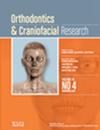Study on the Antibacterial Properties and Optical Characteristics of Clear Orthodontic Aligners Coated With Zinc Oxide and Magnesium Oxide Nanoparticles
Abstract
Objectives
This study aimed to evaluate and compare the antibacterial properties and optical characteristics of clear orthodontic aligners coated with zinc oxide (ZnO) and magnesium oxide (MgO) nanoparticles.
Materials and Methods
In this experimental laboratory study, polyethylene terephthalate glycol (PETG) aligner samples were coated with nanoparticles of ZnO, MgO and a combination of both (ZnO + MgO). The surface coatings were analysed before and after stability testing using field emission scanning electron microscopy (FESEM). Colour changes and translucency were measured using a spectrophotometer, and the antimicrobial and antibiofilm properties were evaluated against Streptococcus mutans and Lactobacillus species. Statistical analysis was conducted using SPSS, with significance set at p < 0.05.
Results
Significant statistical differences were found in the colour changes between the groups (p < 0.001), with the greatest change in MgO-coated aligners (0.94 ± 0.09), followed by ZnO + MgO (0.75 ± 0.05) and ZnO (0.5 ± 0.09). ZnO-coated aligners exhibited the highest translucency (47.6 ± 0.44) compared to MgO (45.07 ± 0.74) and ZnO + MgO (45.76 ± 0.7) (p = 0.002 and p = 0.026, respectively). Nanoparticle-coated aligners showed significantly reduced bacterial growth (p < 0.05). The ZnO + MgO combination demonstrated superior antibacterial effects compared to individual coatings. Nanoparticles remained stable after 24-h agitation in artificial saliva and brushing, maintaining 60%–65% stability.
Conclusion
The aligners coated with ZnO nanoparticles exhibited the least colour change and the highest translucency compared to those coated with MgO nanoparticles and the ZnO + MgO combination. The highest antibacterial properties were observed in the aligners coated with a combination of ZnO and MgO nanoparticles.

 求助内容:
求助内容: 应助结果提醒方式:
应助结果提醒方式:


